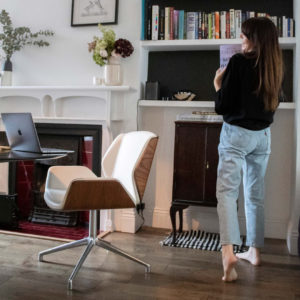WFH21
The Legacy of Lockdown

The work-life paradigm has shifted. A year on from the beginning of the pandemic, we spoke to Marketing Director Kelly Smith & Interiors Visualiser Paul Welch to find out how they’ve been adapting to life and work during the lockdown.
Only 10 miles from Boss HQ in the West Midlands, we visit Selly Park, Birmingham. Home to Paul, 45, a freelance architectural and interiors visualiser (www.pw3d.co.uk), and Kelly, 44, a marketing director for a leading nutritional supplements company. They have one son, Fabian, aged 7.
As a team leader working in the wellness industry, Kelly saw her workload increase dramatically during the first lockdown as people rushed to boost their health, immunity and well-being. But whilst WFH definitely has its plusses, it also has its downsides. In fact, says Kelly, there’s mounting evidence that long-term, it could even be bad for you.
“There’s a lot of research that shows how human interaction or lack of effects your brain. You think you’re still getting the same interaction and experience on a video call, but your brain knows that’s not a real human interaction, so you don’t produce the same amount of hormones like Oxytocin – so it’s actually physically good for you to be around people”.



Health concerns aside, Paul agrees that the pandemic has thrown up a number of pros and cons in the home versus office debate. “In theory, all I need is a desk, a good chair and my computer to do my job, but in reality, the design process by nature is very collaborative. Something that would take 30 seconds in the studio can take much longer via email. And there’s a risk that things get lost in translation remotely. Design projects are often in flux and evolving, so a certain amount of face to face interaction and collaboration is essential.”
Like most families, juggling work and homeschooling was hard going at first, but setting boundaries and making their space work for them was key. Kelly explains: “When we first went into lockdown it was difficult but once we’d started to get to grips with new routines and created designated spaces for all us to work in, things got a whole lot easier.
Paul already has his ‘office’ set up in the spare room and about 10 years ago we bought some Kruze chairs for our dining table so establishing spaces where all three of us could work comfortably and effectively was relatively straight forward”.
In Paul’s industry there’s been talk of remote working for years but the pandemic has fast-tracked the process and will, he thinks, shape the way we live and work for years to come.
“All this has accelerated what was perhaps going to happen anyway in 5-10 years. There have been some huge unexpected benefits to working from home but I think people have also started to appreciate the value of being in the office – of collaborating, interacting and sharing ideas.”
Kelly concludes: “I hope that the legacy of all of this will be that we’ll see companies adopting a more flexible approach to ways of working. A 50/50 split between home and the office would be ideal for me. I love the flexibility of working from home but at the same time I manage a team of people so I like to see them. Lockdown has shown me that whilst it’s possible for me to do my work remotely, I don’t necessarily want to all the time. As with a lot of things in life, ultimately it’s about striking the right balance.
__
Boss Design, February 2021
2008 - 2021

